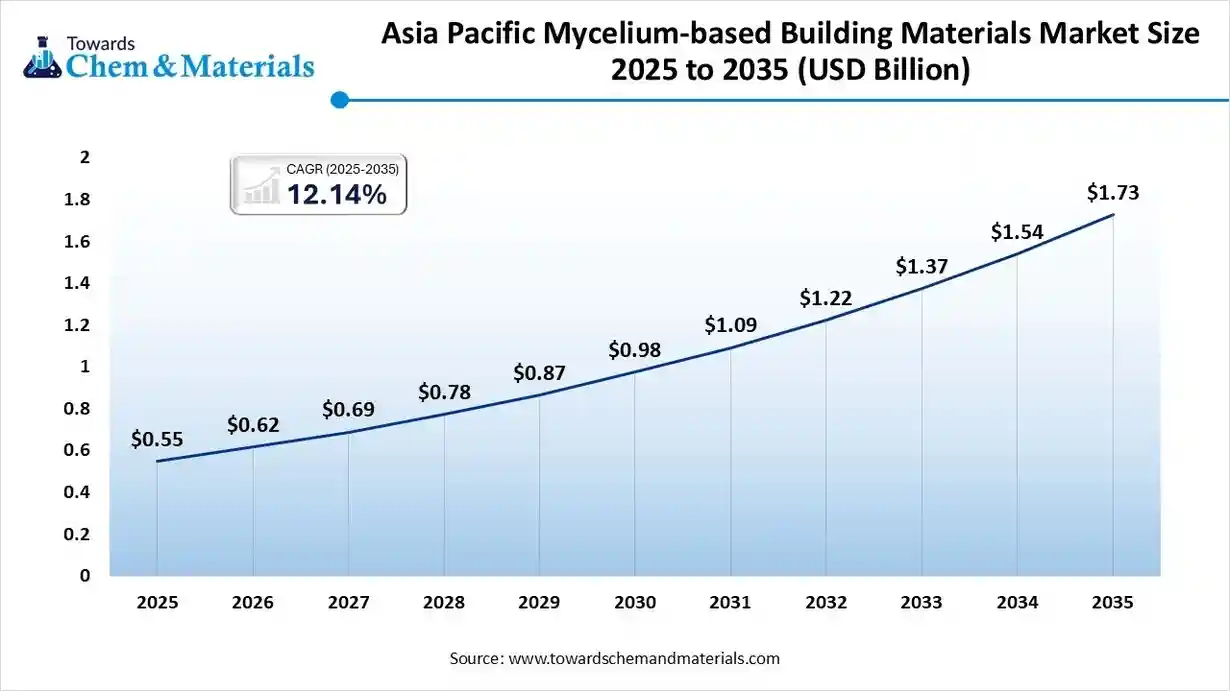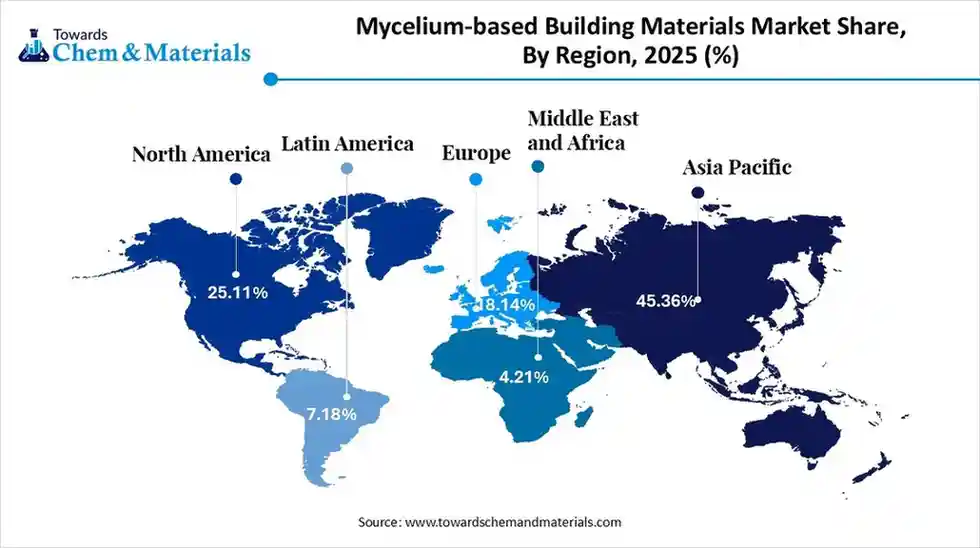November 2025
The global mycelium-based building materials market size is calculated at USD 1.21 billion in 2025 and is predicted to increase from USD 1.36 billion in 2026 and is projected to reach around USD 3.81 billion by 2035, The market is expanding at a CAGR of 12.15% between 2026 and 2035. Asia Pacific dominated the mycelium-based building materials market with a market share of 45.36% the global market in 2025.The global shift towards green building initiatives has fueled industry growth in the past few years.

The mycelium building material refers to the eco-friendly material that is made up of the root-like structure of fungi, as per the observation. Furthermore, by growing through agricultural waste while binding it like natural glue, the mycelium material has become a new, stronger, and lightweight ideal material in the construction sector in recent years. Also, the industry is anticipated to be driven by sustainability mandates and regulations in the coming years.
| Report Attribute | Details |
| Market Size Value in 2026 | USD 1.36 Billion |
| Revenue Forecast in 2035 | USD 3.81 Billion |
| Growth Rate | CAGR 12.15% |
| Forecast Period | 2026 - 2035 |
| Base Year | 2025 |
| Dominant Region | Asia Pacific |
| Fastest Growing Region | North America |
| Segments covered | By Product, ByApplication, By Region |
| Key companies profiled | Myconom Bio Materials, MIMBIOSIS, Mykor, Mogu Srl, Ecovative LLC, MycoFoundry (Canada), COMU Labs Inc., MycoWorks Inc., |
The shift towards the use of Artificial Intelligence and bioformulation tools could result in high-yield outcomes for industrial players in the coming years. Moreover, by controlling mycelium growth with these advanced tools, the manufacturers can gain a significant consumer base in the coming years. Also, advanced technology has seen helping to monitor humidity, CO2 levels, and temperatures with higher accuracy in the past few years, which supports an easy production process.
| Country / Region | Regulatory Body | Key Regulations | Focus Areas |
| United States | Environmental Protection Agency (EPA) | Voluntary Standards (ASTM International) | Establishing standardized testing and performance data for safety |
| European Union | European Commission (EC) | Construction Products Regulation (CPR) (Regulation 2025/3110) | Achieving net-zero emissions by promoting the use of sustainable |
| China | Ministry of Ecology and Environment (MEE) | GB Standards (National Standards) | Meeting national sustainability and carbon neutrality goals |
How did the Mycelium Insulation Panels Segment Dominate the Mycelium-Based Building Materials Market in 2025?
The mycelium insulation panels segment dominated the market share of 38.44% in 2025 due to factors like its easy to grow, fire resistance, and lightweight. Moreover, by fitting directly into walls and roof without the requirement of any expensive tools, the mycelium insulation panels have gained attention from the builder wing in recent years.
On the other hand, the mycelium acoustic panels segment is expected to grow at a significant rate owing to it ability to deliver better sound control without any plastic foam usage. Moreover, spaces like restaurants, offices, studios, and modern homes have seen under a heavy demand for the mycelium acoustic panels in recent years.
The mycelium composites segment is also notably growing, owing to because they combine mycelium with bamboo, hemp, flax, or mineral fibers to create stronger and more durable materials. Builders want something that is lightweight but tough, and composites offer the perfect balance. They are used for wall panels, furniture, modular shelters, and temporary structures.
Why does the Roofing and Insulation Segment dominate the Mycelium-Based Building Materials Market by Application?
The roofing & insulation segment dominated the market share of 33.71% in 2025, because these applications need large volumes of lightweight, thermal-efficient materials, exactly what mycelium provides. Mycelium panels trap air naturally, making them perfect for reducing heat loss in roofs and attics.
The acoustic & aesthetic applications segment is expected to grow at a significant CAGR because it combines functionality with visual design. Modern homes, cafes, offices, and studios want quiet spaces with natural, calming textures. Mycelium provides both excellent sound absorption and a warm, organic look.
The walls and partitions segment is also notably growing because mycelium composites are becoming strong enough for lightweight interior structures. Many offices now prefer removable partitions that are sound-absorbing, stylish, and natural-looking. Mycelium panels meet all these needs while staying eco-friendly.
The Asia Pacific mycelium-based building materials market size was estimated at USD 0.55 billion in 2025 and is projected to reach USD 1.73 billion by 2035, growing at a CAGR of 12.14% from 2026 to 2035. Asia Pacific dominated the global mycelium-based building materials market with the largest revenue share of 45.36% in 2025.

Asia Pacific dominated the mycelium-based building materials market, owing to the availability of heavy raw materials like agricultural waste and others. Moreover, the regional countries such as India, China, and Indonesia have production advantages, such as low-cost labor, and the world's largest and advanced construction industry is driving the regional growth.
Manufacturing Powerhouse: China Drives Rapid Mycelium Material Expansion
China maintained its dominance in the mycelium-based building materials market due to the presence of heavy manufacturing capabilities. Moreover, the country has observed significant investment for the fast growth mycelium strains in the past few years. Furthermore, the government's push towards sustainable manufacturing has provided a significant consumer base to the industry in recent years.
North America Mycelium-based Building Materials Market Examination
North America is expected to capture a major share of the mycelium-based building materials market, owing to the heavy investment in biotechnology, material innovation, and green construction. Also, several major startups in the region have seen in development of the automated mycelium growth systems in the current period. Also, the AI-controlled environment initiatives have gained major industry attention in recent years.
United States Leads the Bio-Fabrication Wave in Sustainable Construction
The United States is expected to emerge as a prominent country for the mycelium-based building materials market in the coming years, owing to a major shift towards mycelium bio-fabrication. Having early access to advanced technology, the region is actively driving the mycelium building material growth significantly. Moreover, the automated growth chambers and engineered components are likely to create opportunities in the coming years.

Europe Mycelium-Based Building Materials Industry Evaluation
Europe is a notably growing region because it has strict environmental rules that push builders to choose sustainable materials. Architects in Europe also prefer natural-looking interiors, making mycelium acoustic and decorative products very popular. The region leads in green construction standards and circular design, which perfectly fit mycelium's biodegradable nature.
Germany Leads the Charge in Next Gen Mycelium Construction Materials
Germany is expected to gain a major industry share because of its strong engineering culture and focus on sustainable construction. German research centers test advanced mycellum composites, improving durability and safety. Many startups work with local farms to convert agricultural waste into building panels.
Mycelium-Based Building Materials Market Study in the Middle East and Africa
The Middle East and Africa are expected to capture a notable share of the mycelium-based building materials market because their hot climate increases demand for natural insulation materials that keep buildings cool. Mycelium panels offer excellent thermal resistance without heavy chemicals. The region is also looking for materials that can be produced locally, reducing dependence on imported construction products.
Saudi Architects Turn to Mycelium for Cooler, Greener Buildings
Saudi Arabia is expected to emerge as a prominent country for the mycelium-based building materials market in the coming years. Saudi architects and developers are exploring mycelium insulation for energy-efficient buildings to handle extreme heat. New innovation hubs and universities are partnering with global researchers to test fungal composites for interior panels, decorative elements, and sustainable packaging.
By Product
ByApplication
By Region
The global polylactic acid market is projected to grow from USD 2.33 billion in 2025 to USD 11.74 billion by 2035, growing at a compound annual growth...
The global green hydrogen market size is accounted for USD 12.85 billion in 2025 and is expected to be worth around USD 413.20 billion by 2035, growin...
November 2025
November 2025
November 2025
October 2025